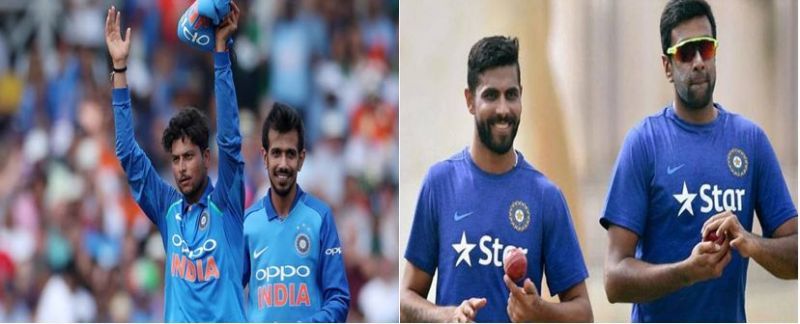
Analysing the transition from finger spinners to wrist spinners in India's limited-overs teams
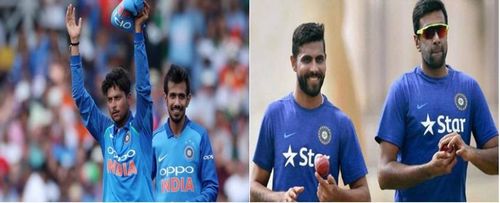
The Indian team has always been blessed with talented spinners. Generally, Indian pitches assist spinners more than pacers, and India's long-term captains in recent years have had at least two premier spinners to deploy.
For instance, take the Sourav Ganguly era, where there was the Anil Kumble-Harbhajan Singh combination. MS Dhoni had the duo of Ravichandran Ashwin and Ravindra Jadeja. And the present team led by Virat Kohli has Kuldeep Yadav and Yuzvendra Chahal.
After taking over the leadership duties from Dhoni in the limited-overs formats, Virat Kohli utilized the spin resources of his predecessor for one last time during the 2017 Champions Trophy. Soon after that tournament, Ashwin and Jadeja were replaced by Kuldeep and Chahal as the first choice spinners. This has hugely modified the bowling options available in the ODI and T20I squads.
But why did this happen, and how has it changed the prospects of the Indian team winning the 2019 World Cup? Let's find out.
Note
- Stats have been considered until the recently concluded ODI and T20I series against New Zealand.
- ODI and T20I Stats for Jadeja and Ashwin have been gathered as per the following timeline:
· T20I stats have been considered from T20 WC 2016 (i.e) 15 Mar 2016 to 9 Jul 2017.
· Jadeja's ODI stats have been considered from WC 2015 (i.e) 15 Feb 2015 to 18 Jan 2019.
· Ashwin's ODI stats have been considered from WC 2015 (i.e) 15 Feb 2015 to 30 Jul 2017.
#1 Percentage of right-handed and left-handed batsmen dismissed:
The most difficult time for the bowlers is when both right and left-handed batsmen are at the crease. One can understand the reason behind this issue. When the strike is rotated, the bowler needs to think of different variations, bowl at different line and lengths to trap the batsmen. Hence, the obvious thing that bowlers would do is bowl over the wicket as well as around the wicket.
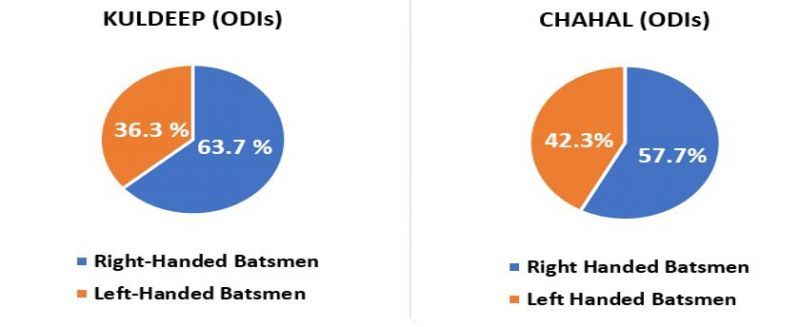
As far as left-arm orthodox bowlers are concerned, they are more vulnerable to southpaws, compared to right-handed batsmen. In that scenario, a wrist spinner is an ideal choice for a skipper. Chahal and Yadav, both being wrist spinners, can spin the ball both ways. Thus, this helps them to dismiss both type of batsmen, and the data is a testament to the same.
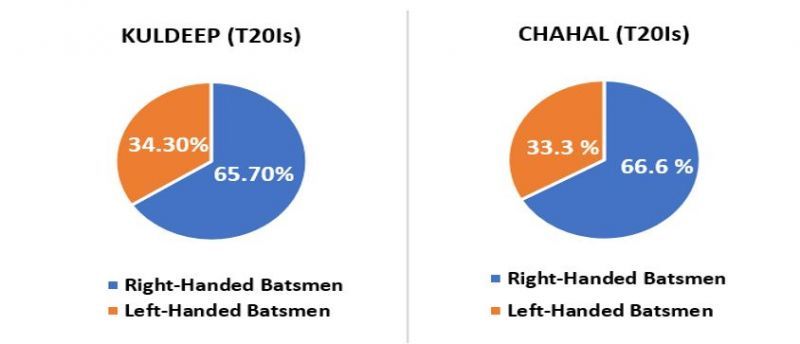
34% and 36% of Yadav's wickets have been left-handed batsmen in T20Is and ODIs respectively. 33% of Chahal's T20I wickets have been left-handed batsmen. In ODIs, the proportion is even higher for Chahal (42%).
#2 Why did the transition from Ashwin-Jadeja to Kuldeep-Chahal take place?
A few players were shown the door from the limited overs squads after the dismal show during the final of the 2017 Champions Trophy. To be more specific, Ashwin and Jadeja were.
Right from the T20 World Cup 2016, the economy and average trends weren't looking good for either of them. It was evident that they were losing their touch in the white ball format and, that the time had come for introducing the next-gen spinners.
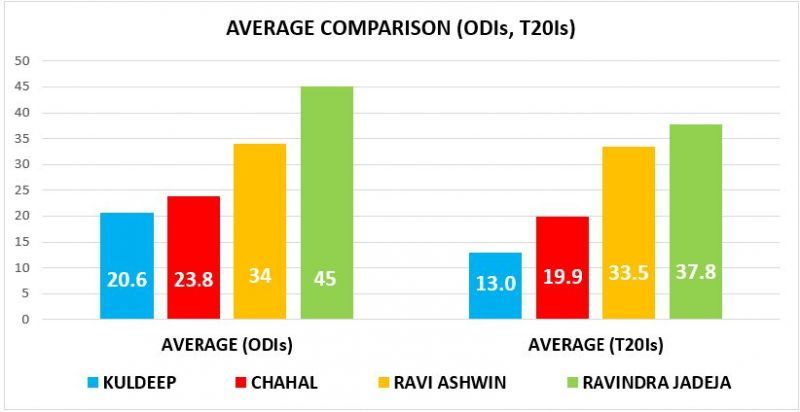
RCB turned out to be the right platform for Chahal to move onto the international stage. Chahal made his debut in 2016 and was the Man of Match in his 2nd international appearance (against Zimbabwe).
Yadav, meanwhile, donned the blue jersey in July 2017 after grabbing the selectors' attention with his Chinaman bowling action. Yadav has been able to bowl googlies more frequently than Chahal.
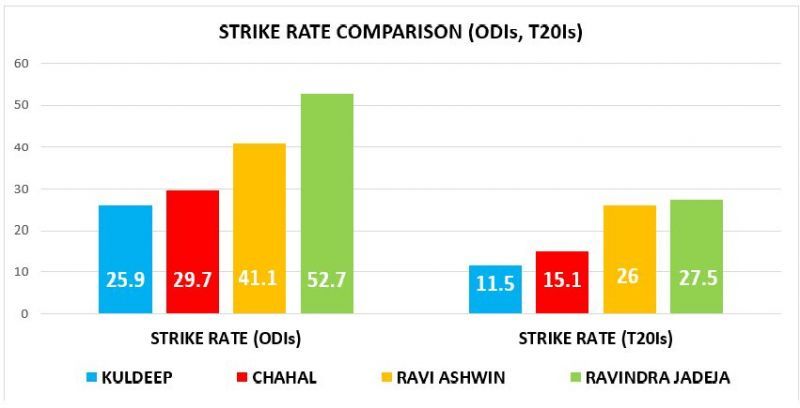
Some of skipper Virat Kohli's decisions have been dubious, but backing these 2 wrist spinners has never been one of them. And the two have repaid the faith of the skipper. On numerous occasions in recent times, they have displayed match-turning performances.
Bowlers with rare skills stay in the limelight for a long time. One such category is the slow left-arm Chinaman bowlers. Very few Chinaman bowlers - like Brad Hogg, Paul Adams, Simon Katich, Tabraiz Shamsi, Kuldeep Yadav - have played a lot of International matches.
#3 Home and away performances
From the charts depicted below, one can correlate that the wicket-taking frequency has been magnificent for the duo. Both of them have pressed the brakes to bring down the rate, under both home and away conditions.
India have played an exhaustive overseas tour against the SENA (South Africa, England, New Zealand and Australia) nations in the last 13 months. And any talented player would be regarded as a home-track bully unless he/she is able to reproduce the same performance overseas. But the duo's ODI performance has been extremely good on away soil, especially when juxtaposed with their showings in home conditions.
Leg spinners are usually known to concede a lot of runs. But the numbers tell a different story in this case. Yes, the average economy of the duo is less than 6.00 in ODIs.
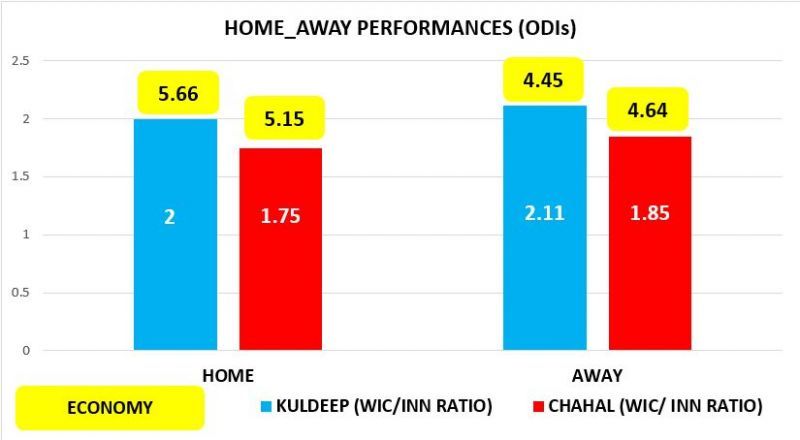
Despite the fact that the pitches in SENA assist pace and swing more than spin, the performances of Chahal and Yadav had been uncompromising under those conditions.
Chahal has picked up 36 wickets in all matches played against SENA. That is approximately 31% of his total career wickets (ODIs + T20Is).
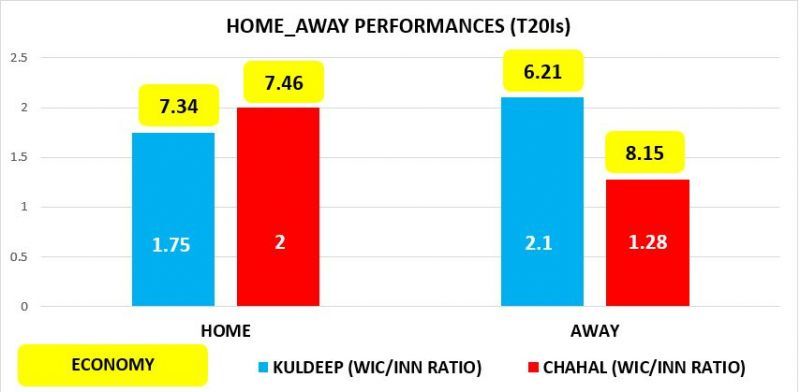
Yadav has had 51 wickets to his name against the SENA countries. This contributes to 45% of his total career wickets (ODIs + T20Is).
We can see that whenever the duo are on the field, one picks wickets while the other tries to limit the runs scored by the batsmen. Adding to that, the duo have turned the pressure well onto the opposition regularly.
That is the best way any duo can complement each other, especially in the field of sports.
#4 Influence of Hardik’s inclusion in selecting Kuldeep and Chahal
India had lacked a proper seaming all-rounder since Irfan Pathan was ousted by the team. Since then, India's bowling combination comprised of 3 pacers and 2 spinners.
Luckily, during the final days of MS Dhoni's captaincy, Hardik Pandya, a seaming all-rounder, made his debut. Pandya is now a part of the team across all formats. Adding to that, his performances have been impressive too.
Hence, the current bowling options of the Indian ODI team are 2 spinners, 2 pacers, and 1 part-time spinner, apart from Hardik.
Jadeja was the replacement for Hardik, whenever the latter failed to be a part of the squad. During those situations, the spin combination was either Jadeja and Yadav or Jadeja and Chahal.
But Vijay Shankar, the Tamil Nadu lad, has turned out to be the ideal fix for this problem. The seaming all-rounder made his T20I debut almost a year ago. He quickly rose to prominence, after playing some crucial knocks in the IPL. As of now, he seems to be the perfect backup for Hardik.
#5 Percentage of total wickets (in ODIs and T20Is) being partnership breakers
Bowlers bowling between the 11th and 40th overs have 2 responsibilities. First, they must control the run-rate. If they fail to do so, then the opposition could set a huge target or chase one with ease.
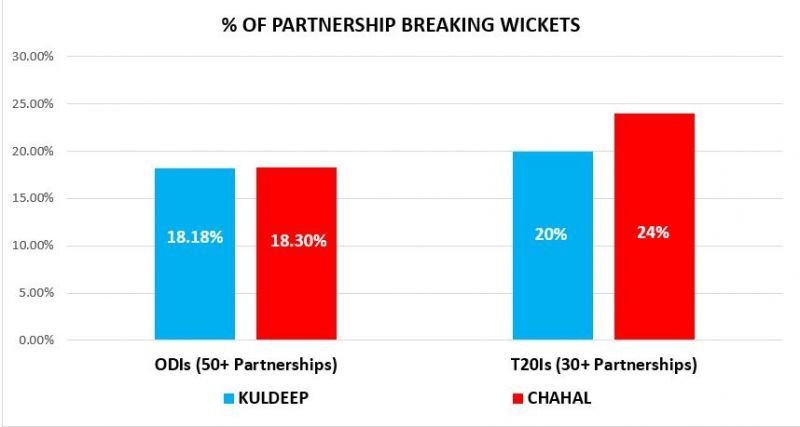
Second, they should break any partnership that looks threatening and solid. Partnerships develop during the middle overs. The bowling team is out of danger if their bowlers fulfil the second task, too.
The facts show that both Yadav and Chahal have completed those tasks successfully on several circumstances.
Indian bowlers who bowl in the middle overs are Hardik, Kedar Jadhav, Yadav and Chahal. It can be observed from the graphs that 18% of Yadav's ODI wickets and 18% of Chahal's ODI wickets have been partnership breakers. Also, 20% of Yadav's T20I wickets and 24% of Chahal's T20I wickets have broken partnerships.
#6 A shortcoming of this duo
Jadeja and Ashwin are known to add runs to the scoreboard with the bat. In contrast, the present spin-duo (KULCHA) hasn't had those many opportunities to replicate the same. This was inevitable since the Indian team has a formidable top-order and great batting depth.
From the stats, it is clear that Kuldeep has batted in 36% and 11% of his ODI and T20I innings respectively. The numbers are much lesser in Chahal's case, where the player has batted in 15% and 7% of his ODI and T20I innings respectively.
Since the head coach of the Indian team Mr. Ravi Shastri has stated that Yadav would be the prime spinner in the forthcoming overseas Tests, the latter's future looks bright. At the same time, Chahal hasn't made his Test debut yet.
Currently, Jadeja and Ashwin are the first team choices in the red ball format. Thus, it will take a minimum of two years for the fans to see the "Kulcha" duo in the longer format.
Until 2021 there are 3 ICC events scheduled, and the first one is set to kick-off in May 2019. As everyone is aware, the last ICC tournament that Dhoni would possibly be a part of is the World Cup 2019.
This duo would need to play a vital role in providing the best possible farewell for Captain Cool and helping the team lift the prestigious silverware.